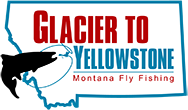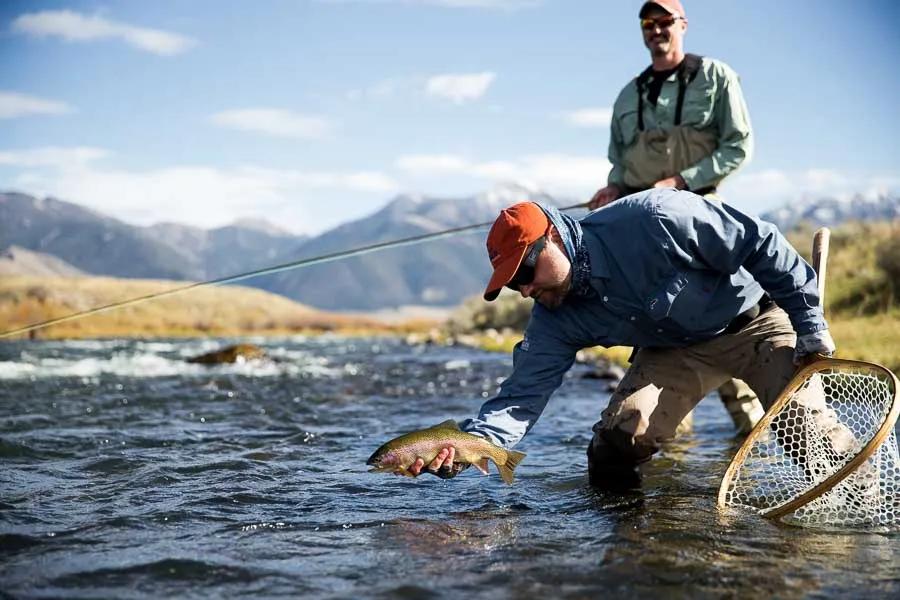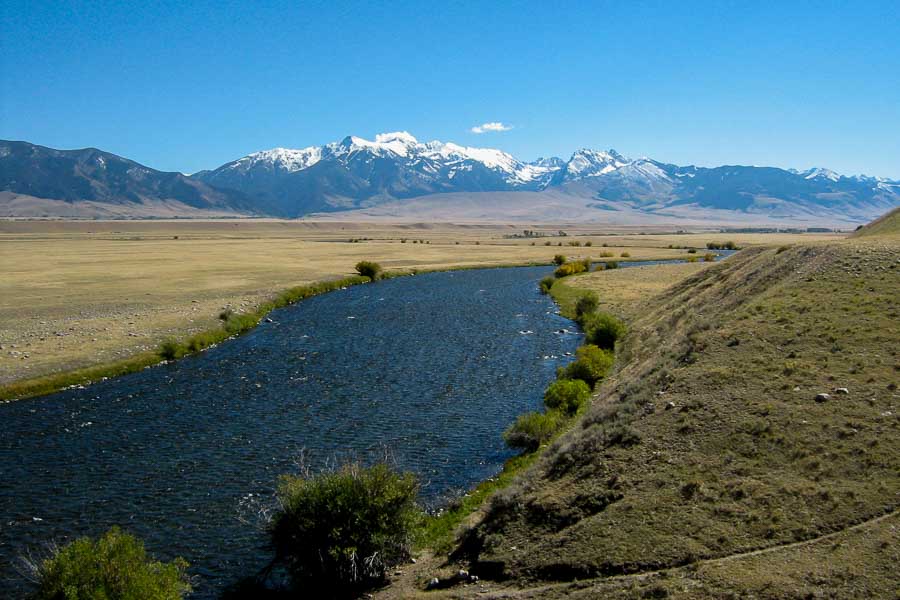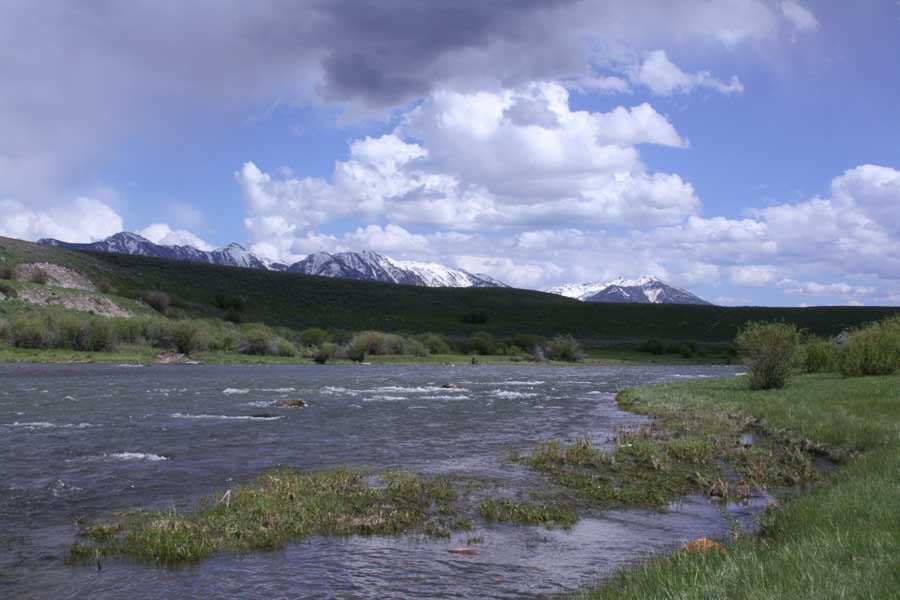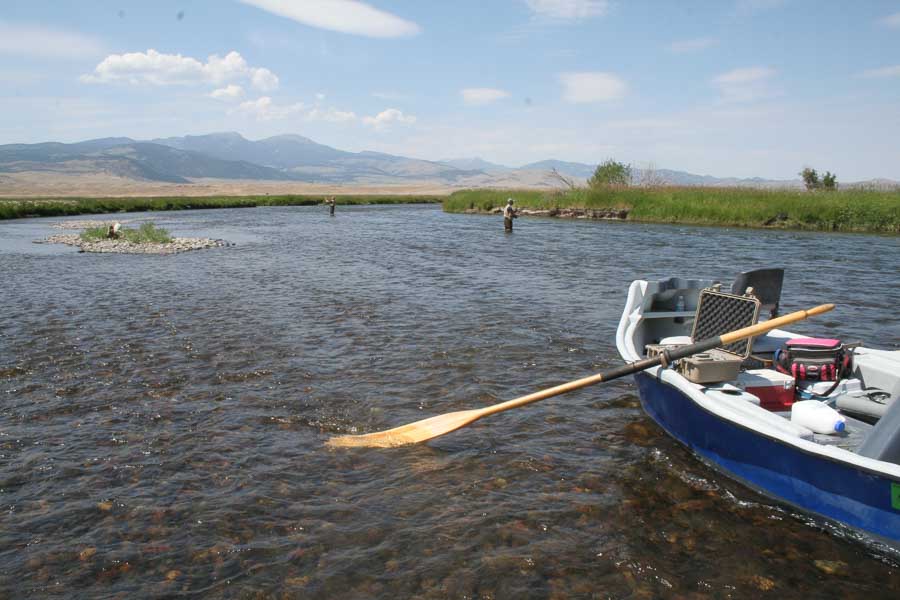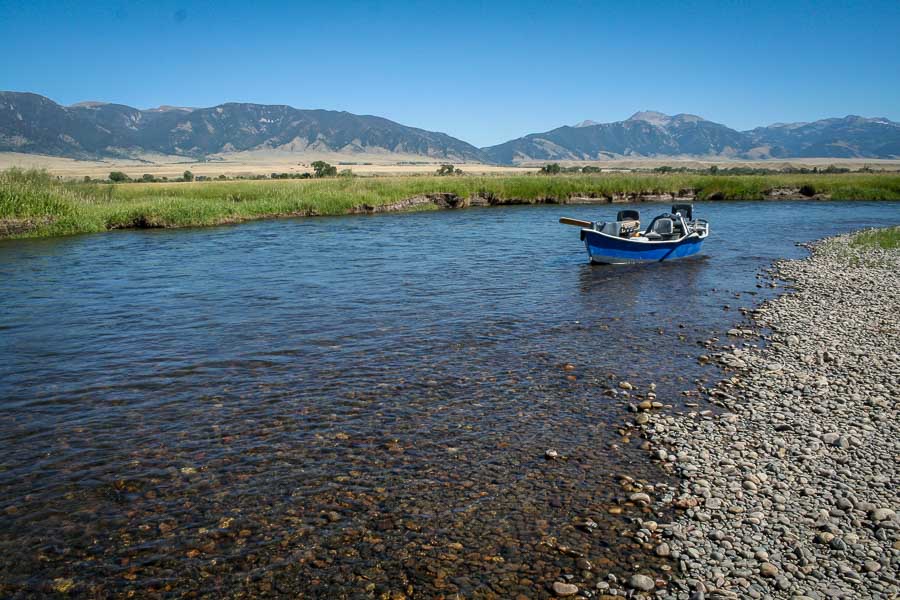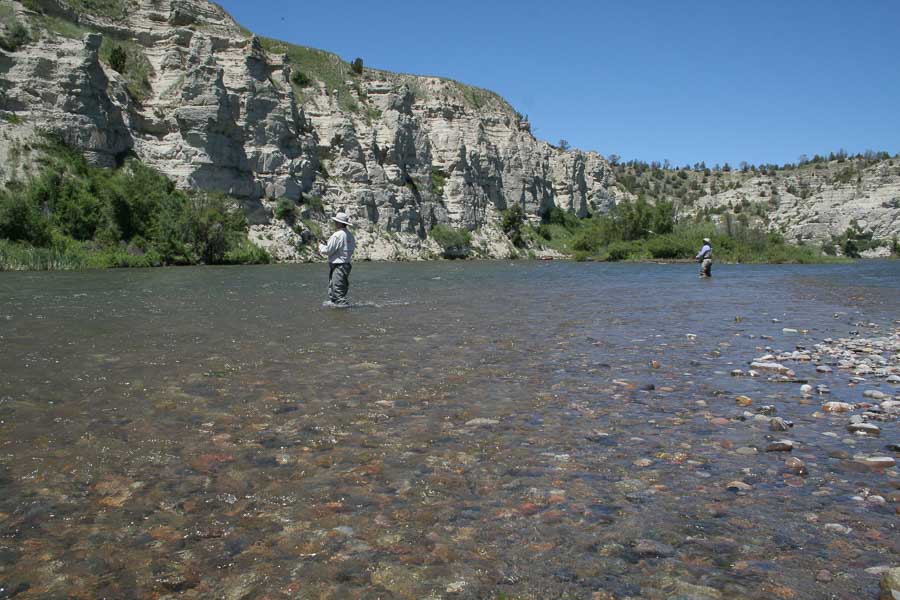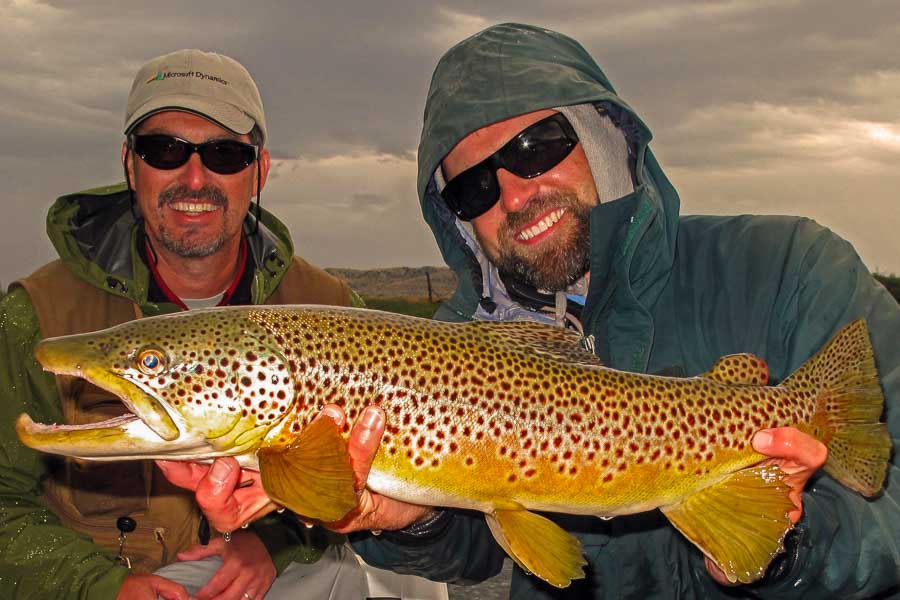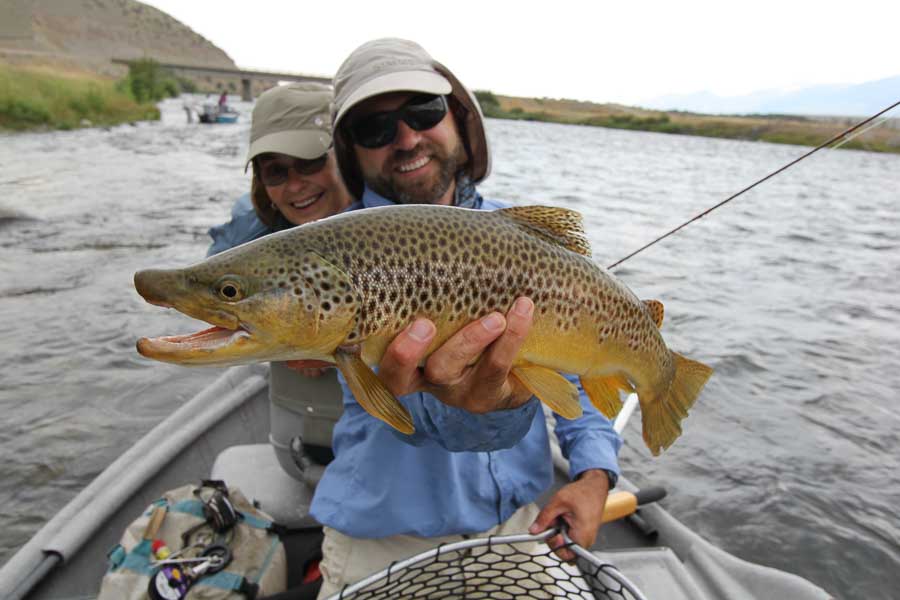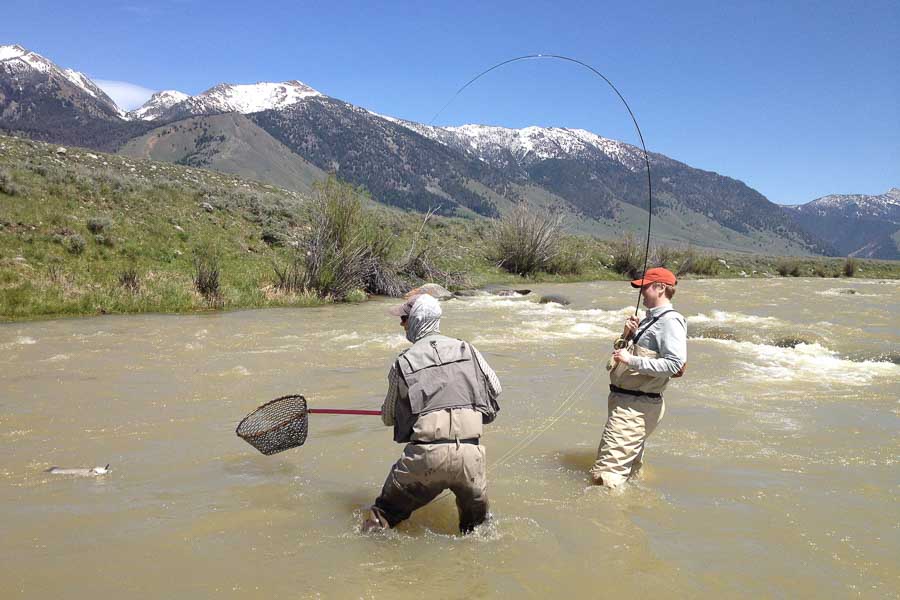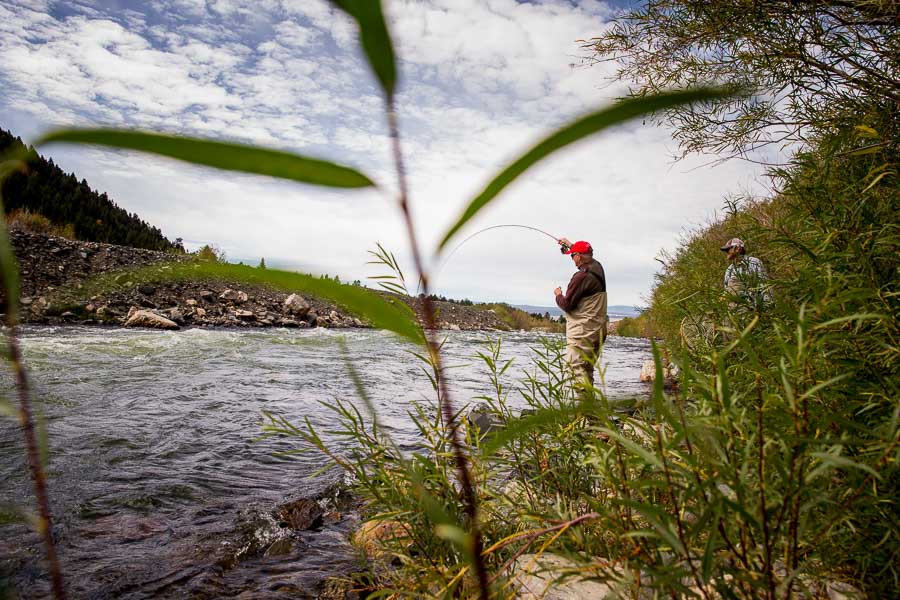Deemed one of the most abundant trout fisheries in the world, the Madison offers great fishing for Brown and Rainbow Trout. Having been ravaged by whirling disease during the 1990’s, trout populations have now recovered to pre-whirling disease levels. The Madison River originates fifteen miles inside of Yellowstone National Park where the Gibbon River joins the Firehole to begin the Madison’s journey. The river stretches for over 130 miles to Three Forks, where it joins the Gallatin and the Jefferson to form the Missouri River. The Madison passes through 3 lakes along its course: Hebgen, Quake, and Ennis. These lakes help to mitigate the effects of spring runoff and consequently the Madison is a productive fishery year round.
Sections of the Madison River
Yellowstone National Park to Hebgen Lake
Fishing the Madison inside of Yellowstone Park is covered here.
Hebgen Lake to Quake Lake
Known locally as "Between the Lakes", this short tailwater stretch fishes very well in the Spring, Fall, and Winter. The water immediately below Hebgen Dam runs clear year round, so it is fishable through spring runoff. A short distance downstream, two tributaries enter the river. In May and June, these can muddy the river downstream from their confluence, leaving a small window of clear, fishable water. Though apt to be crowded, this area is always a good bet. During Spring and early Summer, many Rainbows move up from Quake Lake into this section of the Madison. Because it is such a short section, they are generally not too hard to find. In the Fall, the some big Browns move up out of Quake as well, although the number of Browns in Quake are much lower than Rainbows, so this is a smaller run of fish. Fall does tend to be a little less crowded than Spring, however. Nymphing is by far the best technique here, with streamer fishing picking up some Browns in the Fall. Typical tailwater patterns work best. Good choices include Sow Bugs, Midges, Pheasant Tails, Lightning Bugs, and San Juan Worms.
Quake Lake to Lyon's Bridge
This section of river is often referred to as "The Slide" or "The Wade Section". Fishing from a boat is prohibited in this roughly 10 mile reach, although anglers may use boats to access there favorite fishing spots. This is a very famous section of the Madison, and access points such as $3 Bridge and Raynold's Pass hold a special place in fly fishing lore. Recent rule changes in Montana mean that this section is open to fishing 365 days a year. Previously, it was closed from the end of February until the middle of May, which coincides with the Rainbow Trout spawn. It has been deemed that the Rainbows have recovered so well from Whirling Disease that this regulation is no longer necessary.
This section fishes well year round. Although it does get some color during runoff, it is very rarely too muddy to fish. During high water, the fish are pushed out of the extremely swift main current and hold in the soft pockets of water behind the many boulders and other obstructions. Big and ugly flies like stonefly nymphs and San Juan Worms work well during this time. As the river drops, the fish gradually begin to spread out to different holding areas throughout the river. The river begins to clear, and finer tippets and smaller flies become necessary. Summer hatches include Pale Morning Duns, Yellow Sally's, and Caddis, so dries and nymphs imitating these bugs are good choices. In the Winter, this section sees an excellent midge hatch, and pods of trout sipping off the surface are often encountered in slack water along the banks.
Lyon's Bridge to Ennis
Lyon's Bridge marks the start of the float section of the Madison. This is the stretch that spawned the term "50 Mile Riffle" to describe the Madison River. There are boat ramps and access points every few miles, giving anglers some choices and variety of floats. There are some tributaries that bring mud into the lower half of this section, so there is usually a short window in early to mid June where it is unfishable, but it is typically short lived although often there is enough clarity for great fishing in the upper half from Lyons bridge to the Madison River Lodge. This section is very famous for its Salmonfly hatch, which usually takes place during the last week of June. The hatch will first appear around Ennis and then quickly move upstream, how far and fast it moves in a day is quite unpredictable, and hitting this hatch just right on the Madison takes as much luck, or more, than good planning.
After the Salmonfly's fade, hatches of Golden Stones, Yellow Sallies, and Pale Morning Duns come and go within a few weeks. Caddis stick around all summer, and there are usually some Spruce Moths during early August up around Lyons Bridge. Dry fly fishing on the Madison is pretty hit and miss, but fortunately the nymphing is very consistent.
Ennis Bridge to Ennis Lake
Known as "The Channels" due to its extensive braiding and islands, this stretch of the river is once again restricted to wade fishing only. A boat is nice for access, as the river bank is virtually all private and is a willow jungle at any rate. If you float below the Valley Garden fishing access site you will have to float out into, and row across, Ennis Lake to reach the next ramp. The most popular time to fish here is the fall. This is a nice time because some Brown Trout are moving up from Ennis Lake and the water levels are low. The Channels is tough wading at all flows, but especially during the Spring when levels are high.
Beartrap Canyon
Immediatley below Ennis Dam is an 8 mile wilderness section known as Beartrap Canyon. While there is a boat ramp below the dam, this section is not often floated due to some extremely serious and high consequence whitewater. Trails head into the canyon from both the top and bottom, allowing access for the wade angler. This stretch fishes best in the Spring and Fall, as Ennis Lake tends to warm it pretty significantly during the hottest part of the summer.
The Lower Madison
Below Beartrap Canyon, the river slows and widens and becomes very accessible again. Below the Warm Springs access and boat ramp there is ample access and ramps all the way down to the confluence with the Missouri River. This is the closest float fishing to Bozeman, so it can be busy at times. This stretch is not a good bet in July or August due to warm water temperatures, but fishes well other times of the year. The Mother's Day Caddis hatch here in early May, and that is usually the best dry fly fishing of the year. Like the Upper, the Lower is more of a nymph and stream fishery. The weed beds and sand bars of the Lower harbor lots of crayfish, and this is a very popular fly choice. Other good bets include Caddis imitations such as Princes and Lightning Bugs.
Access
Access
MM=Mileage Marker signs
MM 0: Highway 287 junction with Highway 87 to Henry's Lake, Idaho. The water from Quake Lake to the junction with Highway 87 is both sobering and challenging. The 1959 quake registered 7.8 on the Richter Scale, and an entire mountain slid down on one of the most productive stretches of the Madison for large trout. A campground was buried, and many lives were lost. Almost forty years later, gray pine tree stalks slant from the river, and the boulder strewn heaps of piled high gravel and rock testify to this horrific event. The water looks barren above the junction, but dedicated nymph fishermen take fish in the fast foam and surface film. From the junction to Ennis, a distance of approximately 50 miles, this famous section of the Madison has been described as a 50-mile riffle.
The best time to fish this section of the Madison is early summer and fall. The first awaited hatch is the prolific caddis hatches of late May and June, but the Madison River's salmonfly hatch is justifiably famous and eagerly awaited. But like the Big Hole and Rock Creek, making flight reservations and motel reservations six months in advance can lead to great disappoints when you are confronted with lingering storms, late run-offs, or heavy or late snow accumulations. Hitting it just right is a crap shoot, but if you have the time and the money, it is more than worth the effort.
Traditionally, the hatch starts during the last week of June through mid July followed by the presence of golden stoneflies. With the announcement of, "Gentlemen, start your engines," an interesting rush to the water takes place. Nymph fishermen head upstream above the hatch to chuck 2 inch weighted Bitch Creeks and various other stonefly nymphs into the cold water. Dry fly enthusiasts rush around probing the river and chasing guide rigs. And the leisure set move behind the advancing hatch knowing that trout have orange memories and rise readily to smaller yellow and orange stimulators.
The dog days of August calls for terrestrials, but those enticements are often ignored. One popular and effective technique is to add a bead-head Prince as a dropper. Realistically, during the heat of August, expect to catch smaller fish. By all means pound the water mid day with hoppers, beetles and ants, but do not ignore early morning nymphing techniques and evening hatches of Blue-wing Olives. September and October bring about a change of tactics with heavy streamers.
Wade Lake and Cliff Lake: Wade Lake and Cliff Lake turn off is just downstream from the junction. Both lakes are fairly large and may also be reached from the West Fork Bridge access at mile marker 9.6. Both lakes have campgrounds, but fishing from shore is somewhat difficult due to the steep shoreline. The lakes support healthy populations of 10 to 14 inch trout. Wade Lake Campground offers 30 camping sites, Hill Top Campground offers 20, and Cliff Point offers 6 sites and a trailer boat launch
MM 9.6: West Fork Campground: The West Fork Campground offers seven shaded tent camping sites right along the West Fork of the Madison which is a beautiful stream in its own right, offering fair catches of rainbows and browns. The West Fork may be accessed for almost fourteen miles from on a dirt road. The West Fork blows out early during spring run-off and after a heavy storm. Above the West Fork the river clears earlier due to both the nature of the Park and the addition of Hebgen Lake which tends to settle the silt. Next to the West Fork Campground is the West Fork Cabin Camp and RV Campground.
MM 15.7: Lyon Bridge Recreation Area: Boat launch and picnic area
MM 22.7: Palisades Campground: One mile off the highway, Palisades Campground offers 7 camping sites along side of the river with a towering bluff on the other side.
MM 30.8: McAttee Bridge: McAttee bridge has a day use site as well as a boat launch. Three miles down a well maintened road is the Wall Creek Wildlife Management Area and West Madison Campground. If you like sage brush and full exposure to the sun, then this campground provides 22 camping sites and a boat launch.
MM 38: Cameron, Montana: Cameron has a post office and the Blue Moon Store and RV Park.
MM 40: Varney Bridge (campground): The road to Varney Bridge is over three miles on some rough road. Although the campground has a self-deposit fee requirement, it is somewhat old and run-down. Nonetheless, the five or six campsites are on the river bank with mature cottonwoods providing welcome shade. Most locals take the secondary road out of Ennis on the west side of the river to Varney Bridge.
Floaters can choose a half-day float and spend more time out of the boat fishing by taking out at the Eight Mile Ford boat launch, or they may float down to Ennis Campground. The stretch from Varney Bridge to Ennis Campground, unlike the water upstream, separates into many braided channels and islands. Even with this separation of water, the Madison flows swift against undercut banks and tiny islands. This section has traditionally maintained the largest browns.
Ennis Campground: Just across the bridge from Ennis, Ennis Campground is a shaded campground with mowed grass right on the river. The campground is a Fish, Wildlife and Parks campground with 25 camping sites. Before the bridge crossing, look for the turn off to Valley Garden Campground, which is on the secondary road leading to Bear Trap Canyon. From Ennis Campground to Ennis Lake is closed to float fishing.
Ennis, Montana
The Madison River from Ennis to Three Forks:
Ennis Lake: The lake is shallow, no more than 20 feet in most places. Solar heating of the lake, often reaching close to 80 degrees during the heat of summer, threaten both the trout in the lake and the trout downstream. In spite of this, healthy populations of three to five pound Eagle Lake Rainbows and browns entice boaters and float tubers.
Ennis Lake Outlet to Three Forks: The outlet of Ennis Lake picks up speed as it drops down through the Lee Metcalf Wilderness in Bear Trap Canyon. Bear Trap Canyon is wicked whitewater country and should be avoided unless you are knowledgeable about the vagaries of this rushing canyon water. For floating information contact the Bureau of Land Management, Box 3388, Butte, MT 59702.
Highway 287 splits at the town of Norris and heads to Cardwell and Interstate 90.
The Madison River is reached again by taking Highway 84 to Warm Springs and then to the outlet of Beartrap Canyon. A secondary road, Madison Road, follows the river to Three Forks. The lower Madison is broad and much warmer as a result of the shallow water of Lake Ennis. Lower in elevation, the lower Madison's water temperatures by mid-summer slows down the fishing. Released fish are highly stressed and frequently die. Spring and fall are most assuredly the best time to fish the lower Madison.
